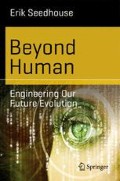Abstract
Humans are fragile organisms. As long as there is enough air and the temperature isn’t too hot or too cold, we function just fine. But, if we’re deprived of air for any length of time, or if the temperature plummets, we’re in trouble. Put simply, we’re not designed to explore the more extreme areas of this planet, or any other planet, without protection. Today, it is nuts and bolts engineering that allows us to explore the ocean depths and journey into space, but in the future it might be a different kind of engineering that allows us to survive—and even thrive—in extreme environments. This is a theme that sci-fi writers have followed for decades; rather than build machines to protect fragile human bodies, sci-fi authors bioengineer their characters’ bodies. Here are some examples.
There is no time to wait for Darwinian evolution to make us more intelligent, and better natured. But we are now entering a new phase, of what might be called, self designed evolution, in which we will be able to change and improve our DNA. There is a project now on, to map the entire sequence of human DNA. It will cost a few billion dollars, but that is chicken feed, for a project of this importance. Once we have read the book of life, we will start writing in corrections. At first, these changes will be confined to the repair of genetic defects, like cystic fibrosis, and muscular dystrophy. These are controlled by single genes, and so are fairly easy to identify, and correct. Other qualities, such as intelligence, are probably controlled by a large number of genes. It will be much more difficult to find them, and work out the relations between them. Nevertheless, I am sure that during the next century, people will discover how to modify both intelligence, and instincts like aggression.Laws will be passed against genetic engineering with humans. But some people won’t be able to resist the temptation, to improve human characteristics, such as size of memory, resistance to disease, and length of life. Once such super humans appear, there are going to be major political problems, with the unimproved humans, who won’t be able to compete. Presumably, they will die out, or become unimportant. Instead, there will be a race of self-designing beings, who are improving themselves at an ever-increasing rate.
Stephen Hawking, in his lecture “Life in the Universe,” 1996
Access this chapter
Tax calculation will be finalised at checkout
Purchases are for personal use only
Notes
- 1.
A key property of DNA is that it can make copies of itself. Each DNA strand in the double helix can serve as a pattern for duplicating the sequence of bases. This is critical when cells divide because each new cell must have an exact copy of the DNA present in the old cell. When these cells are damaged by radiation, mutations can occur because radiation can damage DNA by altering nucleotide bases so they look like other nucleotide bases. When DNA strands are separated and copied, the altered base will pair with an incorrect base and cause the mutation. Radiation can also damage DNA by breaking the bonds, thereby creating a mutated form of the gene, which may produce a protein that functions differently.
Author information
Authors and Affiliations
Corresponding author
Rights and permissions
Copyright information
© 2014 Springer-Verlag Berlin Heidelberg
About this chapter
Cite this chapter
Seedhouse, E. (2014). Designing Humans. In: Beyond Human. Science and Fiction. Springer, Berlin, Heidelberg. https://doi.org/10.1007/978-3-662-43526-7_7
Download citation
DOI: https://doi.org/10.1007/978-3-662-43526-7_7
Published:
Publisher Name: Springer, Berlin, Heidelberg
Print ISBN: 978-3-662-43525-0
Online ISBN: 978-3-662-43526-7
eBook Packages: Chemistry and Materials ScienceChemistry and Material Science (R0)

